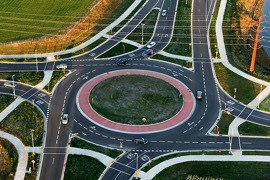Roundabouts emerging as the ideal intersection between driver safety and efficiency
They’ve become the subject of myriad YouTube “how-to” videos. Entire department of transportation websites explain how to navigate them. And, they elicit more than a little anxiety and confusion in the minds of drivers entering, circling and exiting them.

Vehicles travel through a newly-constructed, roundabout intersection at Mineral Point Road, crossing top to bottom, and Pleasant View Road on Madison’s far west side.
Photo: Bryce Richter
Yet, traffic roundabouts are rapidly cropping up in locales ranging from city streets to rural intersections and Interstate off-ramps. In essence, they are the “next big thing” in roadway intersections.
Quite simply, roundabouts provide drivers an efficient, safer alternative to traditional four-way intersections governed by stop signs or traffic signals, says David Noyce, a University of Wisconsin–Madison professor of civil and environmental engineering.
An expert in transportation safety, Noyce directs the Wisconsin Traffic Operations and Safety (TOPS) Laboratory at UW–Madison. “In typical traffic engineering, there’s a tradeoff between safety and operations. Generally, ‘safe’ equals ‘inefficient,'” he says. “Our research has shown roundabouts offer benefits in both of these.”
TOPS researchers have studied not only roundabout safety and “operations,” but also the inner workings of seven software packages transportation engineers use to design roundabouts. They already have presented their findings as testimony at a legislative hearing in Wisconsin and at international transportation research conferences.
From Jan. 22-26, they discussed their roundabouts research in Washington, D.C., at the Transportation Research Board annual meeting, which draws more than 11,000 transportation professionals from around the world.
At the national and international levels, their research not only can improve roundabout design software, but also inform traffic engineers’ decisions related to how to design roundabouts and where to construct them.
In Wisconsin, drivers can encounter any of 150 roundabouts already installed on streets and roads, with another 150 planned by the end of 2015.
For one comprehensive evaluation, TOPS researchers studied 14 Wisconsin multi-lane roundabouts throughout the state. Using video shot at each location, they looked at such factors as vehicle type, driving speed, how drivers enter a roundabout, and the time gap they needed to enter a roundabout.
“People say they’re unsafe because it’s hard to judge the gap,” says Andrea Bill, TOPS traffic safety engineering research program manager. “But even if something happens, your risk of a fatal crash goes way down. We saw video of a driver traveling the wrong way, but everyone was driving through the roundabout so slowly, people could stop. There’s time to slow down and react.”
The researchers also analyzed before-and-after crash data from 24 Wisconsin roundabouts built in or prior to 2007.
“The right-angle crash is one of the most severe crashes,” says Bill. “Roundabouts take away this possibility because drivers are always making a right turn. The crashes are less severe.”
In Wisconsin, as well as at the national level, roundabouts have emerged as being very safe, says Noyce. While some Wisconsin roundabouts showed an increase in crashes, overall the number and severity of crashes decreased and no fatal crashes occurred after a roundabout had been installed in each of the 24 intersections.
“You may not like them personally, but roundabouts have significantly reduced the probability of a severe accident happening,” he says. “I think that’s a contribution to society.”
Enjoy this story?
Read more news from the College of EngineeringTags: College of Engineering, research, traffic
